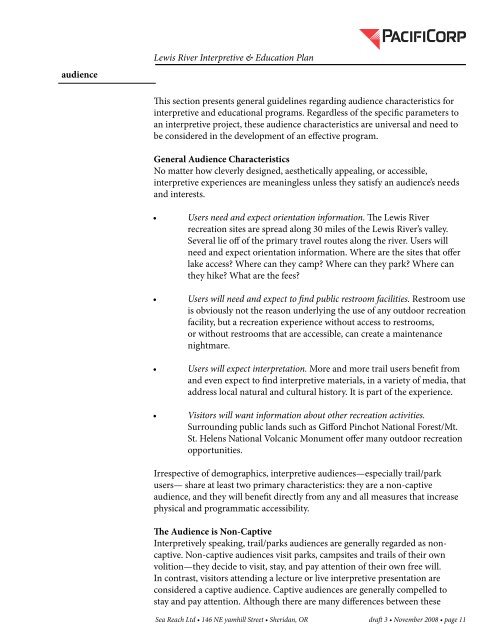The Lewis River Hydroelectric Projects - PacifiCorp
The Lewis River Hydroelectric Projects - PacifiCorp
The Lewis River Hydroelectric Projects - PacifiCorp
Create successful ePaper yourself
Turn your PDF publications into a flip-book with our unique Google optimized e-Paper software.
audience<br />
<strong>Lewis</strong> <strong>River</strong> Interpretive & Education Plan<br />
This section presents general guidelines regarding audience characteristics for<br />
interpretive and educational programs. Regardless of the specific parameters to<br />
an interpretive project, these audience characteristics are universal and need to<br />
be considered in the development of an effective program.<br />
General Audience Characteristics<br />
No matter how cleverly designed, aesthetically appealing, or accessible,<br />
interpretive experiences are meaningless unless they satisfy an audience’s needs<br />
and interests.<br />
• Users need and expect orientation information. <strong>The</strong> <strong>Lewis</strong> <strong>River</strong><br />
recreation sites are spread along 30 miles of the <strong>Lewis</strong> <strong>River</strong>’s valley.<br />
Several lie off of the primary travel routes along the river. Users will<br />
need and expect orientation information. Where are the sites that offer<br />
lake access Where can they camp Where can they park Where can<br />
they hike What are the fees<br />
• Users will need and expect to find public restroom facilities. Restroom use<br />
is obviously not the reason underlying the use of any outdoor recreation<br />
facility, but a recreation experience without access to restrooms,<br />
or without restrooms that are accessible, can create a maintenance<br />
nightmare.<br />
• Users will expect interpretation. More and more trail users benefit from<br />
and even expect to find interpretive materials, in a variety of media, that<br />
address local natural and cultural history. It is part of the experience.<br />
• Visitors will want information about other recreation activities.<br />
Surrounding public lands such as Gifford Pinchot National Forest/Mt.<br />
St. Helens National Volcanic Monument offer many outdoor recreation<br />
opportunities.<br />
Irrespective of demographics, interpretive audiences—especially trail/park<br />
users— share at least two primary characteristics: they are a non-captive<br />
audience, and they will benefit directly from any and all measures that increase<br />
physical and programmatic accessibility.<br />
<strong>The</strong> Audience is Non-Captive<br />
Interpretively speaking, trail/parks audiences are generally regarded as noncaptive.<br />
Non-captive audiences visit parks, campsites and trails of their own<br />
volition—they decide to visit, stay, and pay attention of their own free will.<br />
In contrast, visitors attending a lecture or live interpretive presentation are<br />
considered a captive audience. Captive audiences are generally compelled to<br />
stay and pay attention. Although there are many differences between these<br />
Sea Reach Ltd • 146 NE yamhill Street • Sheridan, OR draft 3 • November 2008 • page 11
















